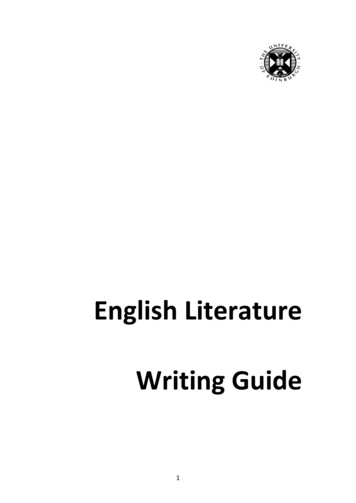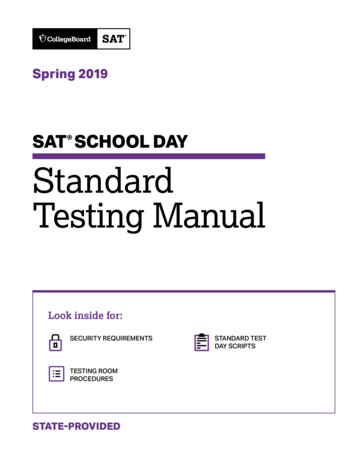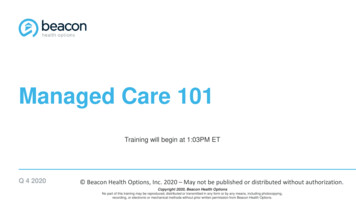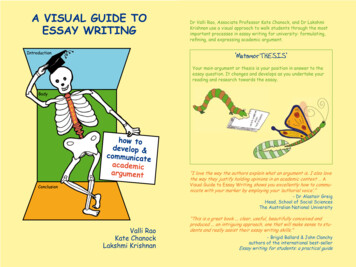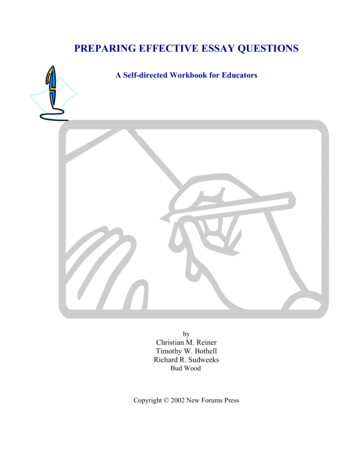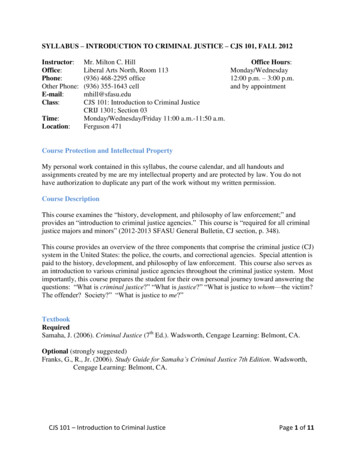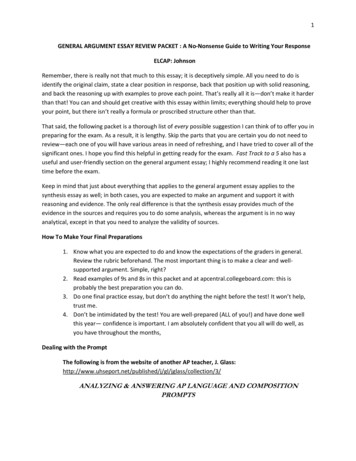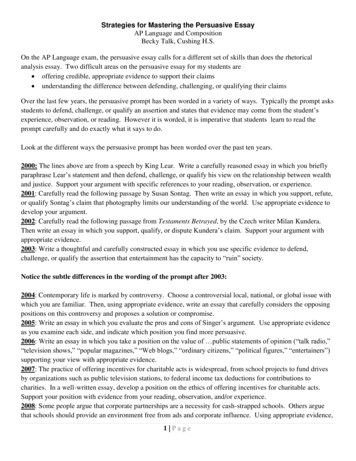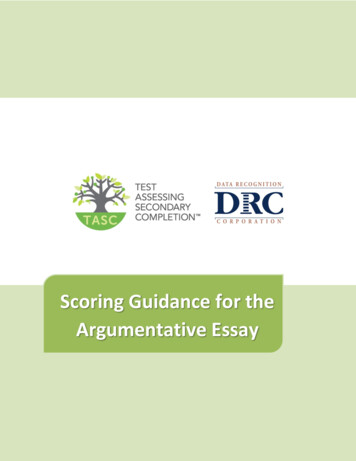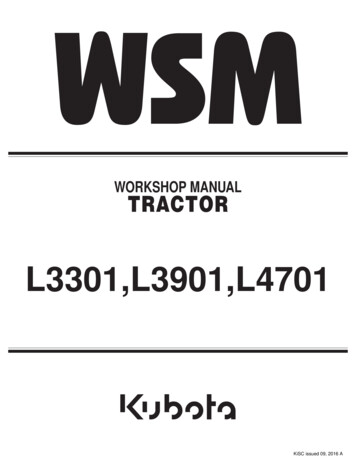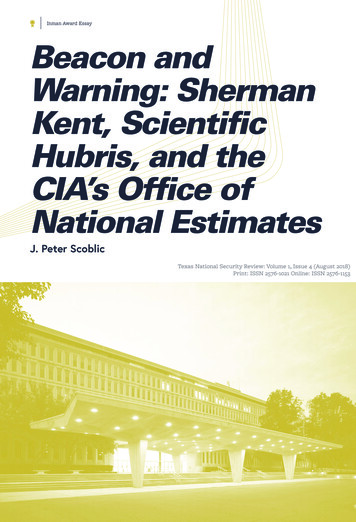
Transcription
Inman Award EssayBeacon andWarning: ShermanKent, ScientificHubris, and theCIA’s Office ofNational EstimatesJ. Peter Scoblic
Beacon and Warning: Sherman Kent, Scientific Hubris, and the CIA’s Office of National EstimatesWould-be forecasters have increasingly extolled thepredictive potential of Big Data and artificial intelligence. Thisessay reviews the career of Sherman Kent, the Yale historianwho directed the CIA’s Office of National Estimates from1952 to 1967, with an eye toward evaluating this enthusiasm.Charged with anticipating threats to U.S. national security,Kent believed, as did much of the postwar academy, thatcontemporary developments in the social sciences enabledscholars to forecast human behavior with far greateraccuracy than before. The predictive record of the Office ofNational Estimates was, however, decidedly mixed. Kent’smethodological rigor enabled him to professionalize U.S.intelligence analysis, making him a model in today’s “posttruth” climate, but his failures offer a cautionary tale for thosewho insist that technology will soon reveal the future.II believe it is fair to say that, as agroup, [19th-century historians] thoughttheir knowledge of the past gave them aprophetic vision of what was to come.1–Sherman Kentt is no small irony that the man who didthe most to develop the U.S. government’sability to predict the future was, by training,profession, and temperament, a historian.In August 1941, just months before the Japanesebombed Pearl Harbor, Sherman Kent was recruitedto join America’s first comprehensive intelligenceagency — the organization that would soonbecome known as the Office of Strategic Services(OSS), the forerunner of the CIA. At the time, Kentwas a 37-year-old professor at Yale, whose Gothicwalls had sheltered him for nearly 20 years: as anundergraduate, as a doctoral student, and then asthe teacher of “History 10,” the freshman courseon European civilization.2 Kent had no military,diplomatic, or intelligence background — in fact,no government experience of any kind. This wouldseem to make him an odd candidate to serveWilliam “Wild Bill” Donovan, a man of intimidatingmartial accomplishment, whom President FranklinD. Roosevelt had recently tapped to set up his spyshop.3Of course, Donovan did not want Kent to be acovert operative. Rather, he wanted Kent to runthe Mediterranean desk of the OSS’s Research andAnalysis Branch. Kent accepted the offer and spentthe war churning out reports that, among otherthings, prepared Allied forces for their 1942 invasionof North Africa. After the war, Kent put off his returnto Yale to spend a year at the newly formed NationalWar College, where he wrote Strategic Intelligencefor American World Policy, a book that outlined aframework for intelligence collection, analysis, anddissemination.4 The book received wide attention1Sherman Kent, “The Historian in Time of Trouble: The Age of Metternich” (paper presented at meeting of the American Historical Association,December 1940), folder 213, box 36, MS 854, Sherman Kent Papers, Manuscripts & Archives, Yale University Library (hereafter Sherman KentPapers).2Sherman Kent, Reminiscences of a Varied Life (San Rafael, CA: The Printing Factory, 1991), 185–86.3Jeffrey T. Richelson, A Century of Spies: Intelligence in the Twentieth Century (New York: Oxford University Press, 1995), 131.4Sherman Kent, Strategic Intelligence for American World Policy (Princeton, NJ: Princeton University Press, 1949).99
Inman Award Essayinside and outside government. Famed columnistsJoseph and Stewart Alsop declared it “the mostimportant postwar book on strategic intelligence.”5Decades later, it is still considered one of the field’sfoundational texts.6It was, in part, on the strength of that bookthat, in 1950, Gen. Walter Bedell “Beetle” Smith,who had been Gen. Dwight Eisenhower’s wartimechief of staff, asked Kent to join him at the CentralIntelligence Agency, which President Harry S.Truman had just appointed him to lead. Kent’srole was “unprecedented in history,” as one CIAhistorian put it.7 He would be deputy director andsoon director of the Office of National Estimates(ONE), charged not simply with analyzing theevents of the Cold War but with anticipatingthem.8 The United States had just been surprisedby North Korea’s invasion of the South, and withthe stakes of the Cold War continuing to rise,another surprise was something that could not betolerated. In Kent’s words,The existence of controllable atomic energyand the dead certainty that others besidesourselves will soon possess the technicalsecrets, place a new and forceful emphasisupon intelligence as one of the most vitalelements in our survival.9Kent never returned to Yale after joining ONE.By the time he left the agency, after 17 years, hewas a legend. As J. Kenneth McDonald, formerlythe CIA’s chief historian, would write, “ShermanKent is a larger than life figure in the history of theCentral Intelligence Agency.”10Such accolades were hard-earned. When Kentjoined the Research and Analysis Branch, U.S.intelligence analysis was a haphazard affair. Bythe time he left the CIA, it was an orderly processstaffed by career analysts who hewed to a strictmethodology that prioritized objectivity in the faceof ambiguity and neutrality in the face of ideology.Kent’s insistence on disinterested analysis gaveONE a degree of independence from Washingtonpolitics, and his reverence for the scientific methodlegitimized its work on prediction. Such effortseasily could have been dismissed as crystal-ballspeculation, but Kent benefited from the postwarscholarly zeitgeist, which held that human systems,like physical systems, were governed by laws thatmade their behavior predictable. Similar to hisacademic contemporaries, Kent ardently believedthat even complex domains, like geopolitics, wereinherently knowable. At ONE, he strove for nothingless than a science of prediction.It is this passion that both complicates Kent’slegacy and makes it particularly relevant today. Onthe one hand, at a moment in which expertise —indeed the very nature of truth — is under attack,11Kent can serve as a much-needed beacon ofreason, a venerable model of Enlightenment valuesand their importance to national security. What’smore, Kent anticipated — by decades — seminalfindings in the field of judgment and decisionmaking, such as the prevalence of overconfidenceand the dangers of confirmation bias, that havevalidated the role of social science in intelligenceanalysis. On the other hand, Kent’s epistemologicalenthusiasm turned out to be hubris. In his beliefthat science could unmask the geopolitical future,Kent overreached. ONE’s estimates were oftenwrong, the experts he revered underperformedas forecasters, and a science of prediction provedelusive.Today’s world is, once again, intoxicated bythe prospect of prediction, hooked this time ona cocktail of Big-Data-enabled machine learning.Artificial intelligence undoubtedly holds greatpromise, but the excitement about its capabilitiesfeels familiar and feverish. So, although ShermanKent stands as a beacon, he may prove even moreuseful as a warning.5 The Alsop brothers quote is from Bret Barnes, “CIA Official Sherman Kent, 82, Dies,” Washington Post, March 14, 1986, 118-42be-b529-7e39f2babaaa/.6 Jack Davis, “Sherman Kent and the Profession of Intelligence Analysis,” Sherman Kent Center for Intelligence Analysis Occasional Papers 1, no.5 (November 2002), -papers/vol1no5.htm.7Donald P. Steury, “Introduction,” in Sherman Kent and the Board of National Estimates, ed. Donald P. Steury (Central Intelligence Agency, 1994),13.8To be precise, William Langer served as director for ONE’s first year, with Kent as his deputy, but Smith had made it clear upfront that Kentwould take Langer’s position when the Harvard historian had to return to Cambridge in 1951. Kent, Reminiscences, 244. On ONE’s remit, see Kent,Reminiscences, 257–58.9Sherman Kent, “Prospects for the National Intelligence Service,” Yale Review 36, no. 1 (Autumn 1946): 116–17.10J. Kenneth McDonald, “Foreword,” in Steury, Sherman Kent and the Board of National Estimates, 7.11 See, for example, Thomas M. Nichols, The Death of Expertise: The Campaign Against Established Knowledge and Why It Matters (New York:Oxford University Press, 2017); and Michiko Kakutani, The Death of Truth (New York: Tim Duggan Books, 2018).100
Beacon and Warning: Sherman Kent, Scientific Hubris, and the CIA’s Office of National EstimatesThe RecruitmentKent was born in California in 1903, the son of abusinessman-politician who served three terms inCongress. In 1921, because nearly every other manin his family had done so,12 he began his studies atYale, where he promptly distinguished himself byflunking freshman history. The failure hit him hard.And because the class was mandatory, he feared hewould be kicked out. “In fact, I was so pessimisticin my outlook,” he later wrote in a self-publishedmemoir, “that whereas every other freshmanbought a big blue Yale banner with the words‘YALE 1926’ on it, I was so sure that I was not longfor the Class of 1926 that I bought a banner thatread simply ‘YALE’.”13Kent retook and passed the class, but he avoidedfurther history courses until he registered for anintroduction to medieval France with John Allison,whom he recalled as “the most interesting andperhaps the most compelling lecturer on the wholefaculty.”14 After graduation, Kent struggled tochoose a profession, vacillating between practicinglaw and teaching high school. It was Allison whosuggested that he pursue his Ph.D. at Yale, a goalthat might be attainable — despite the fact thathis academic record “was no great shakes,” asKent put it — if he applied while professors stillremembered him.15 He followed Allison’s adviceand was accepted. Seven years later, he earned adoctorate in history, specializing in 19th-centuryFrench politics, and joined Yale’s history faculty.In 1941, he was teaching the very class he hadfailed when he got a call from Conyers Read,a historian of Renaissance-era England at theUniversity of Pennsylvania, whom he knew “bothpersonally and professionally.”16 The purpose ofthe call was vague. As far as Kent could tell, Readwas “mobilizing historians” to compile informationfor a government propaganda effort. Kent wasintrigued enough to get on a train to Washingtonto meet with Read and William Langer, a famedHarvard professor of diplomatic history. There,the two told Kent that Roosevelt was forming anagency under Donovan — known initially as theOffice of the Coordinator of Information and, soonafter, as the Office of Strategic Services — thatwould combine intelligence analysis, operations,counterintelligence, and propaganda. They wantedhim to join the analytic branch.As Kent explained in a letter to his mother,It seems that there is a very enormouslygreat damn deal of information coming in tovarious governmental agencies — militaryand naval intelligence, F.B.I., State Dept.etc. — all of it gathered and put together byspecialists in the multitude of special fields.As yet there is no one with the training ordesire to coordinate the dope for purposesof high policy.17Indeed, the prewar coordination of “dope”was poor. Today, the intelligence community —composed of 17 separate organizations, led by thedirector of national intelligence — is an integral partof the U.S. national security establishment. But in1941, there was no such arrangement. The militarycollected information on foreign forces, as it hadduring World War I, and the State Departmentgathered political and economic intelligence, butRoosevelt was happy with neither the soldiers northe diplomats. Kent explained,It seemed that Mr. Roosevelt was farfrom pleased with the kind of intelligencesupport he was getting from the armedforces and was also inclined to disbelieveor give low credence to the political andeconomic information that was cominginto the Department of State from its manydiplomatic missions overseas.18Kent was immediately interested in the job.Although his continuing work on French historywas proceeding well, he had been worrying for12 Antonia Woodford, “Sherman Kent at Yale: The Making of an Intelligence Analyst,” Yale Historical Review 3, no. 1 (Spring 2014): 64, les/spring 2014 yhr web 0.pdf. I am indebted to this article for pointing me to certain correspondencebetween Sherman Kent and his mother.13Kent, Reminiscences, 77.14Kent, Reminiscences, 101.15Kent, Reminiscences, 108–9.16 The information in this paragraph comes from Sherman Kent letter to his mother, Elizabeth Thatcher Kent, Aug. 20, 1941, folder 996, box 50,MS 309, William Kent Family Papers, Manuscripts & Archives, Yale University Library (hereafter William Kent Family Papers).17Sherman Kent letter to his mother, Aug. 27, 1941, folder 996, box 50, MS 309, William Kent Family Papers.18Kent, Reminiscences, 185–86.101
Inman Award Essaymonths about “how remote and useless this sort ofresearch appears in the light of our crisis values,”19which is to say that Adolf Hitler’s conquest ofEurope made Bourbon France seem a bit arcane.The job with the Office of the Coordinator ofInformation seemed like a chance to use his skillsto participate in the war (or, at this point, prewar)effort. What’s more, Read and Langer assured himhe would be working alongside some of the mostimpressive scholars in the country: “Apparentlythe lure of the work has been enough to get the realtop men in history, geography, and economics fromall over the country.”20 He accepted the offer andwithin two weeks was in Washington, serving aschief of the Mediterranean division in the office’sResearch and Analysis Branch, or “R&A.”To understand why a man of action like BillDonovan was mobilizing historians to supply thepresident with intelligence may require denizensof the digital age, constantly bombarded as theyare by multiple streams of information, to thinkabout what “information” meant in the mid-20thcentury. In 1941, information was stored on paper,catalogued on cards, and retrieved by people, notcomputers. What’s more, in contrast with today’sservice- and information-based economy, theeconomy of the early 1940s was dominated bymanufacturing and agriculture. Only 5 percent ofthe adult population had a college degree.21 Thatmeant that only a tiny sliver of the populationcould be considered “knowledge workers,” intoday’s parlance — people with the skills to find,collate, and process vast amounts of information,19especially information on far-flung localesand esoteric subjects. Chief among them wereacademics.After World War I — during which U.S.intelligence efforts had grown substantially — theArmy and Navy had been charged with maintaininga “constant flow of information from almost everypart of the world,” according to Kent.22 Had theydone so, by the time the Japanese bombed PearlHarbor, the United States would have had hundredsof encyclopedic volumes on various countries andtopics. Instead, the information gathered did notseem to be enough to fill a single volume. As Kentdescribes,From our visits and meetings with thevarious intelligence officers of the ArmedForces, we had some pretty solid evidencethat any active intelligence work must haveended with the First World War. Therecould be no speedier way to bring to lightthe shocking state of U.S. intelligence thanthe imminent outbreak of war.23The problem the United States faced asit approached a globalshowdown with the Axispowers was how to collect,synthesize, and present massiveamounts of information aboutforeign countries and potentialtheaters of battle. That is why,when the Office of the Coordinatorof Information was first conceived,Archibald MacLeish, the librarian ofCongress,gatheredrepresentativesfrom several tweedy organizations — theAmerican Council of Learned Societies, theSocial Science Research Council, and theNational Archives — to determine who among themcould best advise the new research-and-analysiseffort.24 It was often academics — historians,political scientists, and geographers — who knewthe most about the foreign lands the United Stateswould be fighting in, and they knew how to getinformation they did not have and distill the datainto a readable product.Sherman Kent letter to his mother, March 12, 1941, folder 995, box 50, MS 309, William Kent Family Papers.20 Sherman Kent letter to his mother, Sept. 12, 1941, folder 997, box 50, MS 309, William Kent Family Papers.21 “1940-2010: How Has America Changed?” U.S. Census Bureau, March 14, 2012. /comm/1940-census-change.html.22Kent, Reminiscences, 198.23Kent, Reminiscences, 187–88.24Richelson, Century of Spies, 204.102
Beacon and Warning: Sherman Kent, Scientific Hubris, and the CIA’s Office of National EstimatesHowever well-prepared his profession was forthe task, Kent was shaken by his introduction toR&A:I’ve been new to many jobs before, but I’venever been new to a new job. I’ve neverbeen set down (or far better) stood up to dosomething, anything, not knowing how todo it [and] been unable to find anyone whohas more dope than myself. It is a shatteringexperience.25A set of notes from his first weeks on the jobcontains questions ranging from the mundane(“Do I need one of those badges. Where do I getit.”) to the fundamental (“Will research carried onbe primarily of [a] strategic nature”).26 As he laterrecalled,There were few in Washington who couldgive any guidance as to how to go aboutthe business at hand. What intelligencetechniques there were, ready and available,were in their infancy. Intelligence was tous at that period really nothing in itself; itwas, at best, the sum of what we, from ouroutside experience, could contribute to a jobto be done.27One expectation was met, however: Read andLanger’s promise that he would be working withthe top scholars in the country was borne out.Many of Kent’s colleagues were at the peak oftheir profession. James Phinney Baxter was thepresident of Williams College. John Fairbank wasthe country’s leading Sinologist. Hajo Holborn wasthe Sterling professor of history at Yale. There weredozens and dozens more. As historian Robin Winksput it, “The list of historians who worked for theOSS reads like a Who’s Who of the profession.”28By contrast, Kent was not yet a full professor. Hewas probably tapped for the job because, like nearlyeveryone who was hired, he knew someone — inhis case, Conyers Read — who was doing the hiring.But there were one or two other factors that mighthave pushed him higher on Read’s list. The firstwas a committee that Kent founded at Yale, in 1939,dedicated to collecting prewar German propagandaand preserving it for the historical record.29The second was a talk he gave to the AmericanHistorical Association in December 1940 underthe heading “The Historian in Time of Trouble,”in which he described historians who, at times ofpolitical unrest, had stepped out of the ivory towerto guide the political process: “It was the scholarstatesman who knew the points of reference inthe past and could use them as guides to the rightregulation of future public affairs.”30 Both activitiesbroadcast Kent’s desire to do something of grandpurpose during a time of global crisis. And, becausemidcentury academia was an old boys’ club — andbecause, as a Yale faculty member, Kent sat at oneof its most exclusive tables — it may not havetaken much prompting for Read to call him thatAugust day in 1941.31Research and AnalysisWhatever the proximate cause of Kent’s hiring,he rapidly distinguished himself at R&A.Kent arrived in Washington with a well-definedway of thinking — or, more accurately, a welldefined way of thinking about how one shouldthink. Kent was not an ideologue — far from it. Hewas a methodologist. In fact, when Read had calledhim to service, he had just been wrapping up theproofs of a book on the proper way to do history.Writing History was intended primarily as a primerfor undergraduates who had to produce theirfirst history papers. (Reading the book, one getsthe sense that Kent was tired of seeing the samemistakes in each iteration of his “History 10” class.)But the volume also serves as a succinct guide to25 Sherman Kent letter to his mother, Sept. 6, 1941, folder 997, box 50, MS 309, William Kent Family Papers. It is not clear what Kent was referringto when he wrote that he had been new to many jobs before, given that he had worked at Yale his entire career.26 Sherman Kent, untitled notes that Kent dates to “about 10 Sept 1941,” folder 58, box 43, MS 854, Sherman Kent Papers.27 Sherman Kent, “The Need for an Intelligence Literature,” Studies in Intelligence 1, no. 1 (September 1955), -intelligence/kent-csi/vol1no1/html/v01i1a01p 0001.htm.28 Robin W. Winks, Cloak & Gown: Scholars in the Secret War, 1939–1961 2nd ed. (New Haven, CT: Yale University Press, 1987), 495.29 Woodford, “Sherman Kent at Yale,” 80.30 Kent, “The Historian in Time of Trouble.”31 The clubbiness of Research and Analysis is vividly demonstrated by Kent’s description of his own hiring practices: “My first and most pressingtask was to begin recruiting staff for my Mediterranean section. Rudolph Winnacker immediately came to mind he was a fellow French historianwhose interests and sympathies often paralleled my own. It was Bill Langer who directed us to Rick (Richard P.) Stebbins who had done hisgraduate work at Harvard. Soon after Dick, we hired Henry Cord Meyer from Yale where he was doing his graduate work on ‘Mittel Europa’ underHajo Holborn. I had been close to Holborn while at Yale and was happy to invite Henry with Hajo’s strong recommendation. Also largely onHolborn’s advice we recruited Bob (Robert G.) Miner. Bob was also doing his graduate work at Yale. Another one of our early recruits and againfrom Yale was Henry L. Roberts.” Kent, Reminiscences, 100–02.103
Inman Award EssayKent’s faith in reason, the scientific method, andthe search for truth.The “most serious” reason to study history, hewrote, is that it brings the student into “intimatecontact with the chief philosophical assumptionsbehind his existence. For if his work [is to]have any merit at all, it will have come from thesystematic nature of his research and thought.”32He continued: “Chiefly does ‘systematic’ studyimply skepticism of things taken for granted.”33 ToKent, such skepticism — the willingness to criticizeassumptions, particularly one’s own — was theessence of history, of estimable thought in general.What’s more, he maintained, rational, systematicthought is what enables social progress.Although Kent stressed the importance ofnarrative in history, he saw the discipline as “akinto the method of science which Francis Bacon putforth in the early seventeenth century.” Specifically,Kent wrote,It consists of gathering facts. It consistsof forming hypotheses on the basis of thesefacts, of testing these hypotheses for tracesof one’s own ignorance or bias, of cleansingthem if possible. The goal of research is tobuild better hypotheses than already existand to establish them as relatively moretrue: it is to reveal a sharper picture of whathappened and to make a closer approach toactuality than anyone has yet contrived.34Writing History was a manifesto for realizingtruth through the scientific method, intellectualflexibility, and unrelenting skepticism of theevidence.Kent brought this attitude directly to Researchand Analysis, whose purpose, he noted, “was tryingby the method of science to approach truth.”35 Ashis close colleague Harold P. Ford would later note,Closely paralleling the theory and practiceof professional intelligence were certainof the principles of the historian’s callingSherman Kent enunciated in his first [sic]book, Writing History, which he had writtenwhile at Yale. In many of the passages oneneed only substitute the words ‘intelligenceofficer’ for ‘historian.’36In that scholarly attitude, Kent both reflectedand contributed to the approach of R&A writ large.The Research and Analysis Branch became knownas “the Campus” not simply because it comprisedsome 900 scholars but because their methods,far from being clandestine, relied so heavily onlibraries and other open-source materials, suchas government testimony, newspaper articles, andradio reports. Donovan, who lacked no flair forthe dramatic, embraced the “Bad Eyes Brigade”because he could see just how much informationthey could pull from the most prosaic of sources.37Kent spent his first day on the job at the Libraryof Congress retrieving articles from the AmericanHistorical Review and the Journal of ModernHistory “in an effort to discover what Americanshave written on the fine red Mediterranean.”38 Itwould quickly become clear that the R&A scholarscould produce most of what the military (andother elements of the war effort) needed simply byhitting the books. As Winks put it, “R&A controlledthe most powerful weapon in the OSS arsenal: thethree-by-five index card.”39R&A was like a university in another crucialrespect: its tolerance, and even encouragement,of free thinking — an approach that was rare inthe bureaucracy and the military but that couldproduce brilliant ideas and reduce the risk ofartificial consensus. Kent later explained the needto tolerate idiosyncrasy:In a sense, intelligence organizations mustbe not a little like a large university faculty.They must have the people to whom researchand rigorous thought are the breath of life,and they must accordingly have tolerancefor the queer bird and the eccentric with aunique talent. They must guarantee a sort ofacademic freedom of inquiry and must fightoff those who derogate such freedom bypointing to its occasional crackpot finding.4032 Sherman Kent, Writing History (New York: F.S. Crofts & Co., 1941), 4.33 Kent, Writing History, 5.34 Kent, Writing History, 29–30.35 Sherman Kent, “Research and Analysis Branch, 1943–1945,” folder 58, box 43, MS 854, Sherman Kent Papers.36 Ford, “A Tribute to Sherman Kent,” 26. Kent’s first book was actually Electoral Procedure Under Louis Philippe (New Haven, CT: Yale UniversityPress, 1937).37 Winks, Cloak & Gown, 67.38 Sherman Kent letter to his mother, Sept. 6, 1941.39 Winks, Cloak & Gown, 62–63.40 Kent, Strategic Intelligence, 74.104
Beacon and Warning: Sherman Kent, Scientific Hubris, and the CIA’s Office of National EstimatesBut R&A was unlike a university faculty in a fewimportant ways — ways that not only helped itswork but that also foreshadowed developments inthe academy itself by many years. For one thing,R&A did not merely encourage but demandedcollaboration among its scholars. Whereas manyacademics were used tobeavering away in solitudeon a project for years on end,the breadth of knowledgeneeded for any one projectand the speed with whichreports had to be producedrequired cooperation. Thatcooperation rankled egos,and some argued thatcollaboration actually dilutedthe scientific method since no single person wouldcollect the data, draw hypotheses, test them, and,if necessary, start over.41 Yet analysts had no choicebut to work together given wartime deadlines. AsKent noted, R&A might have had the aura of auniversity, but it had the pace of a newsroom.42R&A also forced its 900 scholars to work acrossdisciplines. The bureau included historians,economists, political scientists, inks notes, “Since intelligence required itsown methodology, R&A would derive thismethodology from several disciplines.”44 But suchinterdisciplinary cooperation was not normal forthe time. In particular, the economists, with theirmathematical models, chafed at working withcolleagues from less quantitative fields and showeda tendency toward bureaucratic expansionism:“We have taken over Europe. We are moving inon the Far East and we will shortly get going onthe USSR,” one junior economist wrote.45 As JackDavis, a CIA expert on Sherman Kent, quipped,“One of Kent’s legendary achievements was totalk reluctant economists into serving under thedirection of an historian.”46The first real test of such coordination — and41of Kent himself — came in August 1942, whenDonovan told R&A that the Allies were planningto invade North Africa and needed informationon the region immediately. North Africa fellwithin Kent’s brief, and, in a marathon 50-hoursession, he and the R&A staff produced a reporton Morocco, followed by reports on Algeria andTunisia. The military was impressed by boththe rapid response and the sheer breadth of thereports, and, Winks writes, “Donovan told theunit that they had produced ‘the first victory’ forR&A’s methodology.”47 According to Davis, “TheNorth Africa reports helped make R&A’s reputationwith the military as a valuable win-the-war asset.The event also made Kent’s reputation as a risingstar in the new world of intelligence research andanalysis.”48 Kent continued to make himself usefulwithin the organization, advancing where therewere openings, and, by the end of the war, hisreputation had spread.Washington had taken notice of R&A’saccomplishments. The volume of information thatthe analysts processed — during a single week in1943, the branch was inundated with 45,000 pagesof foreign material — was staggering. Their outputwas even more so — some 3,000 reports on apreposterously wide range of topics.49 Intelligencehistorian Jeffrey Richelson describes the scope oftheir efforts:The subjects of R&A studies covered a vastnumber of economic, political, sociological,Winks, Cloak & Gown, 69.42 Kent, Strategic Intelligence, 75.43 Central Intelligence Agency, “The Office of Strategic Services: Research and Analysis Branch,” and-analysis.html.44 Winks
2 Sherman Kent, Reminiscences of a Varied Life (San Rafael, CA: The Printing Factory, 1991), 185–86. 3 Jeffrey T. Richelson, A Century of Spies: Intelligence in the Twentieth Century (New York: Oxford University Press, 1995), 131. 4 Sherman Kent, Strategic Intelligence for American World

